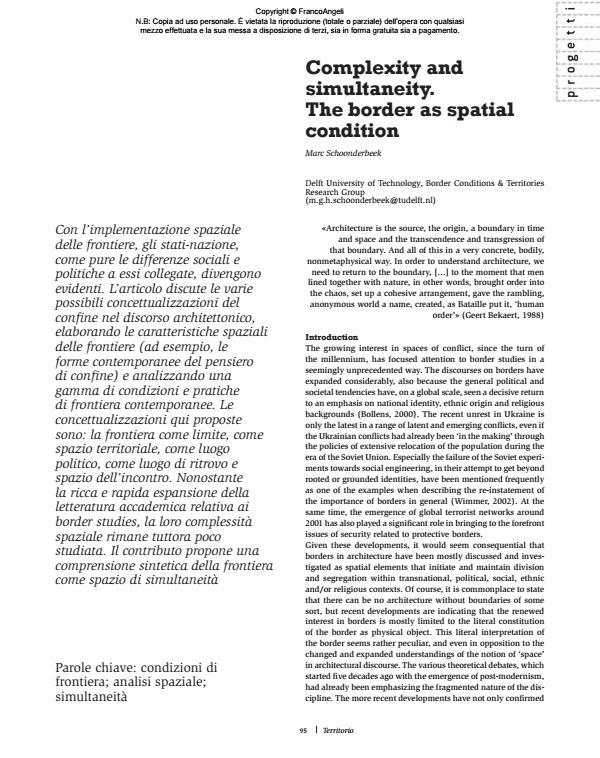Complexity and simultaneity. The border as spatial condition
Journal title TERRITORIO
Author/s Marc Schoonderbeek
Publishing Year 2015 Issue 2015/72
Language English Pages 6 P. 95-100 File size 252 KB
DOI 10.3280/TR2015-072015
DOI is like a bar code for intellectual property: to have more infomation
click here
Below, you can see the article first page
If you want to buy this article in PDF format, you can do it, following the instructions to buy download credits

FrancoAngeli is member of Publishers International Linking Association, Inc (PILA), a not-for-profit association which run the CrossRef service enabling links to and from online scholarly content.
Con l’implementazione spaziale delle frontiere, gli stati-nazione, come pure le differenze sociali e politiche a essi collegate, divengono evidenti. L’articolo discute le varie possibili concettualizzazioni del confine nel discorso architettonico, elaborando le caratteristiche spaziali delle frontiere (ad esempio, le forme contemporanee del pensiero di confine) e analizzando una gamma di condizioni e pratiche di frontiera contemporanee. Le concettualizzazioni qui proposte sono: la frontiera come limite, come spazio territoriale, come luogo politico, come luogo di ritrovo e spazio dell’incontro. Nonostante la ricca e rapida espansione della letteratura accademica relativa ai border studies, la loro complessità spaziale rimane tuttora poco studiata. Il contributo propone una comprensione sintetica della frontiera come spazio di simultaneità
Keywords: Condizioni di frontiera; analisi spaziale; simultaneità
- Spatial Appropriations Over Europe’s Borderland: El Principe’s Growth as a Vestige of Colonial Urbanism Mari Paz Agundez, in Urban Planning 6942/2024
DOI: 10.17645/up.6942 - Using the potential of photography to narrate the urban border: a case study in the XII Arrondissement of Paris Michael Devereux, in Articulo – revue de sciences humaines /2025
DOI: 10.4000/15er1
Marc Schoonderbeek, Complexity and simultaneity. The border as spatial condition in "TERRITORIO" 72/2015, pp 95-100, DOI: 10.3280/TR2015-072015